A Cross-sectional Survey Assessing Knowledge, Attitude, and Practice Regarding Oral Cancer among Private Medical and Dental Practitioners in Bhubaneswar City
CC BY-NC-ND 4.0 · Indian J Med Paediatr Oncol 2017; 38(02): 133-139
DOI: DOI: 10.4103/ijmpo.ijmpo_107_16
Abstract
Introduction: Oral cancer is a public health problem giving rise to a great number of disabilities and deaths, but the possibility of survival is astonishingly higher when detected early. Health professionals therefore have an important role and responsibility in the prevention and early detection of oral cancer. They should be in a position to identify all suspicious lesions and to search for specialist opinion as promptly as possible when unsure, while also referring to the most appropriate discipline. Aim: This study aimed to assess the knowledge, attitude, and practices (KAPs) regarding oral cancer among private medical practitioners (MPs) and private dental practitioners (DPs). Materials and Methods: A cross-sectional, questionnaire-based study was conducted among 334 MPs and 201 DPs in Bhubaneswar. A self-designed, close-ended questionnaire containing 28 items was delivered to the practitioners in their clinics. Correlation between KAP among MPs and DPs was done by Karl Pearson's correlation coefficient test. Student's t-test was used to compare the KAP among the practitioners. Results: Of the 535 practitioners approached, 513 filled the questionnaire with a response rate of 95.88%. Significantly, the mean knowledge index was higher among DPs (10.96 ± 1.85). The attitude index was higher in the MPs (6.89 ± 1.11), and the practice index was higher among the DPs (4.95 ± 0.91). Conclusion: The study puts forward the need of further training for both MPs and DPs to increase awareness and to strengthen their abilities to diagnose potentially cancerous intra-oral lesions.
Keywords
Dental practitioners - early detection - medical practitioners - oral cancerPublication History
Article published online:
06 July 2021
© 2017. Indian Society of Medical and Paediatric Oncology. This is an open access article published by Thieme under the terms of the Creative Commons Attribution-NonDerivative-NonCommercial-License, permitting copying and reproduction so long as the original work is given appropriate credit. Contents may not be used for commercial purposes, or adapted, remixed, transformed or built upon. (https://creativecommons.org/licenses/by-nc-nd/4.0/.)
Thieme Medical and Scientific Publishers Pvt. Ltd.
A-12, 2nd Floor, Sector 2, Noida-201301 UP, India
Abstract
Introduction:
Oral cancer is a public health problem giving rise to a great number of disabilities and deaths, but the possibility of survival is astonishingly higher when detected early. Health professionals therefore have an important role and responsibility in the prevention and early detection of oral cancer. They should be in a position to identify all suspicious lesions and to search for specialist opinion as promptly as possible when unsure, while also referring to the most appropriate discipline.
Aim:
This study aimed to assess the knowledge, attitude, and practices (KAPs) regarding oral cancer among private medical practitioners (MPs) and private dental practitioners (DPs).
Materials and Methods:
A cross-sectional, questionnaire-based study was conducted among 334 MPs and 201 DPs in Bhubaneswar. A self-designed, close-ended questionnaire containing 28 items was delivered to the practitioners in their clinics. Correlation between KAP among MPs and DPs was done by Karl Pearson's correlation coefficient test. Student's t-test was used to compare the KAP among the practitioners.
Results:
Of the 535 practitioners approached, 513 filled the questionnaire with a response rate of 95.88%. Significantly, the mean knowledge index was higher among DPs (10.96 ± 1.85). The attitude index was higher in the MPs (6.89 ± 1.11), and the practice index was higher among the DPs (4.95 ± 0.91).
Conclusion:
The study puts forward the need of further training for both MPs and DPs to increase awareness and to strengthen their abilities to diagnose potentially cancerous intra-oral lesions.
Introduction
It is well recognized that cancers of the oral cavity and pharynx are public health problems, and as a result, there are a great number of deaths and people suffering from illness or disability in many of the developed countries.[1] India, among the Asian subcontinent, presents with higher incidence of head and neck cancer contributing up to 7.8% of the global cancer burden and 8.33% of global cancer deaths. More than 2 lakh new cases of head and neck cancers are diagnosed every year.[2] The variation in the incidence and pattern of oral cancer is due to regional differences in the prevalence of risk factors. However, since oral cancer has well-defined risk factors, these may be modified giving real hope for primary prevention.[3]
Identification of the problem necessitates addressing the problem and strengthening preventive interventions in health care globally as well as at the oral health level. Oral cancer in India has been recognized as a grave problem. Public health officials, health providers, and academic medical centers are redeemed in motivating the community, and in the interim, redefining the major shortcomings is necessary. Out of the many shortcomings, the awareness of the public regarding the condition remains a massive causative factor, and putting efforts to understand the fundamentals related to etiology, predisposing elements, progression of cancer, conventional symptoms, necessary investigations, and management protocols is mandatory.
Despite the fact that the oral cavity is accessible for visual examination and that oral cancer and premalignant lesions have well-defined clinical diagnostic features, oral cancers are typically detected in their advanced stages. In fact, in India, 60%–80% of patients present with advanced disease as compared to 40% in developed countries which is in consistent with patients presenting for medical care with more advanced disease in India compared with developed countries with alarmingly reduced overall survival.[3]
The recognition and early detection of oral cancer not only guarantees an increase in the survival rate, but also guarantees an improvement in the quality of life as a result of less aggressive, mutilating, and costly treatments. To achieve this, it is important that health professionals, especially dentists (DPs) and medical practitioners (MPs), perform oral cancer examinations as part of their clinical practice and should be especially aware of not only the pathogenesis of the disease, but also the first clinical signs. Till date, no major prognostic improvement has been observed since the MPs and DPs often overlook the early signs for the disease and diagnosis is made at an advanced stage.[4]
A good deal of literature is available on DPs’ awareness regarding oral cancer. However, very little data is available on MPs’ awareness regarding oral cancer. Since patients often consult their MP for oral lesions, this study included assessing the knowledge, attitude, and practice (KAP) regarding oral cancer among private MPs and DPs in Bhubaneswar city.
Thus, early diagnosis and identification of high-risk patients is essential for better response to therapy and improved prognosis. Hence, this study was undertaken to assess the KAPs regarding oral cancer among the private MPs and DPs in Bhubaneswar city.
Materials and Methods
A cross-sectional, descriptive, questionnaire-based survey method was carried out to assess the level of KAP regarding oral cancer among the private MPs and DPs in Bhubaneswar city, Odisha. The list of all the registered private MPs and DPs was obtained from the state directories of the Indian Medical Association (IMA) and Indian Dental Association, respectively. Prior to conduct of the study, ethical clearance was obtained from the Institutional Review Board, KIIT University, which was considered as a part of the study in the form of confidentiality of the respondents, freedom of expression, and informed consent.
A total of 201 private International Development Association-registered DPs and 334 IMA-registered MPs are present in Bhubaneswar city. All the registered practitioners, practicing in Bhubaneswar, were selected for this study. This study was conducted over a period of 3 months. After informing the participants about the aim of this study and obtaining the consent, questionnaires were given to them in their clinics personally. Participation was voluntary.
The questionnaire was divided into various sections of sociodemographic data and KAPs toward oral cancer. The questionnaire was prepared in English containing 33 items. The face validity of the questionnaire was tested by distributing it to the interns posted in the department where certain modifications were done and the time required to fill the questionnaire was assessed. The next step included assessing the content validity in which the modified questionnaire was distributed among the expert panel which was formed by the faculty members in the department. Five questions with an Aiken's index of <0 xss=removed href="https://www.ncbi.nlm.nih.gov/pmc/articles/PMC5582549/bin/IJMPO-38-133_Suppl1.pdf" id="d35e189" xss=removed>Questionnaire 1].
Questionnaire 1
Questionnaire 1: Knowledge, attitude, and practice regarding oral cancer among private medical and dental practitioners in Bhubaneswar city: A cross-sectional survey
The results were hypothesized with response scores which significantly related to the level of KAPs regarding oral cancer among the study participants.
The data were transformed from precoded pro forma to a computer through a master file which was created for the purpose of data analysis. 95% confidence interval was used to find the significance of proportion of KAPs. Chi-square test was used to test the significant difference in proportions and percentages between both the groups. Means were compared using t-test. P < 0>
Karl Pearson's coefficient correlation test was used to find the correlation between KAP among both the groups. Statistical software SPSS for Windows, Version 16.0. (SPSS Inc. Released 2007, Chicago, SPSS Inc.) system was used for analysis. Microsoft Word and Excel sheet were used to generate tables and graphs.
Results
Out of the 535 practitioners, 513 practitioners participated in the study with a response rate of 95.88%. Table 1 shows the majority of the participants in this study to be males (63.74% [n = 327]) and only 36.25% (n = 186) to be female respondents.
Table 1
Distribution of medical and dental practitioners by gender

|
Figures Figures11 and and22 show the majority of MPs to be in the age group of 51 years and above (88.24%) and majority of DPs to be in the age group of 31–40 years (89.47%). The mean age of MPs was 47.23 ± 8.12 and that of DPs was 38.17 ± 7.90.
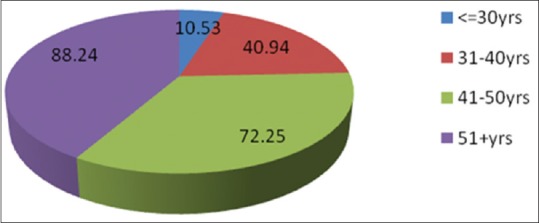
| Figure 1:Age distribution of medical practitioners
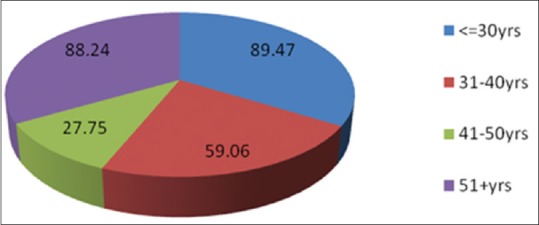
| Figure 2:Age distribution of dental practitioners
Table 2 and Figure 3 show the mean knowledge index score among DPs and MPs to be significant. The attitude index score for both the groups was 6.39 and 6.89, respectively, which was also a significant finding. The practice index score for both the groups was 4.95 and 4.20, respectively.
Table 2
Comparison of medical and dental practitioners with respect to knowledge, attitude, and practice scores
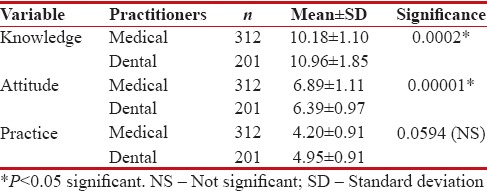
|
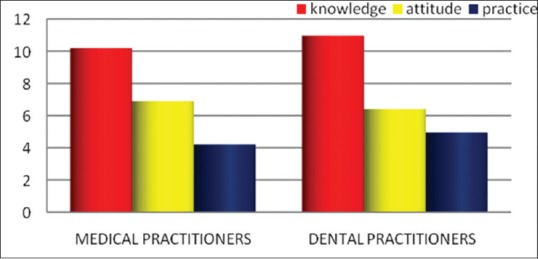
| Figure 3:Comparison of medical and dental practitioners with respect to knowledge, attitude, and practice scores
Based on the KAP scores, it was found in this study that, the majority of the participants in the age group of 51+ years had a higher score for knowledge and attitude. However, the practitioners in the age group of ≤30 years had a higher practice score as shown in Table 3.
Table 3
Comparison of age groups of practitioners with respect to knowledge, attitude, and practice scores
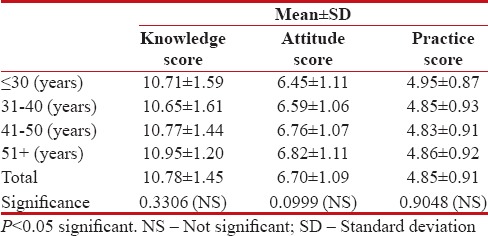
|
It was seen in this study that the knowledge and attitude scores and, knowledge and practice scores for both the group of practitioners were significantly correlated. The knowledge and attitude scores were significantly correlated for the DPs, and the knowledge and attitude scores and, knowledge and practice scores were significantly correlated for the MPs as shown in Table 4.
Table 4
Correlation between knowledge, attitude, and practice scores among both the groups
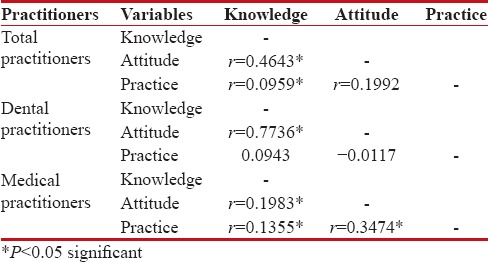
|
Discussion
Oral cancer is the sixth most common cancer in the world. Globally 267,000 new cases and 128,000 deaths are reported annually, of which two-third of cases are contributed by the developing countries.[5] It is associated with one of the most dismal 5-year survival rates of the major cancer types. Being aware of the major risk factors for oral cancer and its associated conditions and the ability to identify the early lesions of oral cancer are therefore vital for both the prevention and early detection of the disease.
The cancer crisis is universal; the only variation occurs in types, site, or other clinico-epidemiologic parameters. Tobacco chewing was identified as its cause about a century ago and continued practice and research proved it as the most important avoidable factor of oral cancer.[3]
The known risk factors for oral cancer are tobacco use and alcohol consumption. Identifying patients’ tobacco and alcohol use, whether current or past, is crucial for a practitioner to be knowledgeable about his or her patient's risk of developing oral cancer.[6] Recently, infection with certain types of human papillomavirus has also been linked to oropharyngeal cancer. Owing to the multitude of causes that could possibly hinder the prognosis, early detection is, thus, crucial.[7]
In South Asia, oral cancers account for about up to 40% of all cancers. In India, the incidence of oral cancer is about 3–7 times more common as compared to resource-rich countries. Our country tops in the prevalence of oral cancer in the world and remains the most common cancer among the male population. Oral cancer is the third most common cancer in India after cervical and breast cancer among women. The age-standardized incidence rate of oral cancer is reported at 12.6/100,000 people. The amplified prevalence of oral cancer in the Indian subcontinent seems to be due to the high exposure to sunlight due to farming, smoking, and other smokeless tobacco habits, alcohol, spicy food, and neglect of overall oral health. It is said that one-third of all oral cancers are preventable and one-third of them occur due to risk factors.[3] Oral cancer has not left the resourceful countries untouched. In the United States, for example, tobacco in the form of snuff and chew and certain lifestyle and environmental factors do pose as risk factors.[8]
Oral cancer can occur anywhere in the mouth, including the lips, tongue, and throat, as well as the salivary glands, pharynx, larynx, and sinuses. A lot of patients with oral symptoms such as ulcers, sores, swellings, areas of red or white lesions in the mouth or lips, numbness, pain or tenderness anywhere in the mouth, including tongue or problems with chewing, swallowing, or speaking present at first to their general practitioner. Early detection and diagnosis of this disease spectrum by not only the DPs, but also by the MPs is therefore of utmost importance in its successful treatment, and thus directly affecting prognosis.
Despite the fact that the oral cavity is accessible for visual examination and that oral cancers and premalignant lesions have well-defined clinical diagnostic features, oral cancers are typically detected in their advanced stages.[9]
The practitioner who deals with any kind of oral pathology must for this reason, be in a situation to identify all suspicious lesions and be prepared to ask for professional guidance when unsure. At the same time, he or she should be able to refer the patient to the most appropriate discipline.[10]
In a study carried out in the United Kingdom, it was revealed that the individuals at greatest risk for oral cancer rarely visit a DP but do consult general MPs and thus concluded that these practitioners could play an important role in the early detection of oral cancer.[11] Thus, there was the need to assess the KAP of both the DPs and MPs.
As expected, notably, more DPs than MPs had a higher score for knowledge and practice questions. Interestingly, the MPs had a better attitude than the DPs regarding oral cancer. This was consistent with a previous study by Carter and Ogden.[11] This may be attributed to the fact that professional courses that familiarize DPs with the more common and important oral diseases enhance their diagnostic abilities than the MPs. A survey done by Sitheeque et al.[12] on awareness of oral cancer and precancer among final year medical and dental students of Universiti Sains Malaysia showed the dental students to not have differed significantly in some areas of knowledge from their medical colleagues. The authors pointed to a necessity to strengthen these aspects of medical and dental undergraduate curricula. Similar studies were done by Alami et al.[13] to assess the knowledge of oral cancer among recently graduated medical and dental professionals in Amman, Jordan. The results revealed an inadequate level of knowledge of oral cancer among the study population, with significant differences between the dental and medical professionals. The authors suggested a need for improvement of the undergraduate curriculum in oral cancer in both medical and dental schools and for the provision of postgraduate and continuing education on this topic.
The findings in the present study concerning dentists’ attitudes related to oral and pharyngeal cancer suggest strongly that educational interventions for practitioners and dental students are necessary. The current survey also reveals that further training is required for both MPs and DPs to increase awareness of oral cancer and its associated risk factors and to strengthen the practitioners’ abilities to diagnose potentially cancerous intra-oral lesions.
Conclusion
In the end, it is critical that both general MPs and DPs possess sufficient knowledge of the signs and symptoms of malignant and premalignant oral cavity lesions for the sake of early and effective diagnosis.[14] While many MPs perceive members of the dental team to have the greater role in the prevention and detection of oral cancer, they may be prepared to become more involved in examining the mouth, particularly those of high-risk patients. The present findings showed that DPs had a better knowledge and practice regarding oral cancer. However, MPs had a better attitude related to oral cancer. Based on the results of the present study, we may arrive at a judgment that more education is needed in dental schools, postgraduate and continuing education programs to enhance health professionals’ knowledge of oral cancer risk factors and diagnostic concepts.
Financial support and sponsorship
Nil.
Conflicts of interest
There are no conflicts of interest.
Acknowledgment
The authors would like to thank all the practitioners for their valuable time and patience. The authors would also like to thank Mr. S. Javali, statistician, for giving valuable insight into the statistical analysis of this study.
References
- Colella G, Gaeta GM, Moscariello A, Angelillo IF. Oral cancer and dentists: Knowledge, attitudes, and practices in Italy. Oral Oncol 2008;44:393-9.
- Prasad LK. Burden of oral cancer: An Indian scenario. J Orofac Sci 2014;6:77.
- Khan Z. An overview of oral cancer in indian subcontinent and recommendations to decrease its incidence. Webmed Central Cancer 2012;3:WMC003626.
- Alaizari NA, Al-Maweri SA. Oral cancer: Knowledge, practices and opinions of dentists in Yemen. Asian Pac J Cancer Prev 2014;15:5627-31.
- Van der Waal I, De Bree R, Brakenhoff R, Coebergh JW. Early diagnosis in primary oral cancer: Is it possible? Med Oral Patol Oral Cir Bucal 2000:E217-22.
- Vijay Kumar KV, Suresan V. Knowledge, attitude and screening practices of general dentists concerning oral cancer in Bangalore city. Indian J Cancer 2012;49:33-8.
- Available from: https://www.report.nih.gov/nihfactsheets/ViewFactSheet.aspx?csid=106. [Last accessed on 2016 May 04].
- Available from: http://www.who.int/oral_health/disease_burden/global/en/. [Last accessed on 2015 Jul 12].
- Coelho KR. Challenges of the oral cancer burden in India. J Cancer Epidemiol 2012;2012:701932.
- Bater MC, Jones D, Watson MG. A survey of oral and dental disease presenting to general medical practitioners. Qual Prim Care 2005;13:139-42.
- Carter LM, Ogden GR. Oral cancer awareness of general medical and general dental practitioners. Br Dent J 2007;203:E10.
- Sitheeque M, Ahmad Z, Saini R. Awareness of oral cancer and precancer among final year medical and dental students of Universiti Sains Malaysia (USM), Malaysia. Arch Orofac Sci 2014;9:53-64.
- Alami AY, El Sabbagh RF, Hamdan A. Knowledge of oral cancer among recently graduated medical and dental professionals in Amman, Jordan. J Dent Educ 2013;77:1356-64.
- Preventing and controlling oral and pharyngeal cancer. Recommendations from a National Strategic Planning Conference. MMWR Recomm Rep 1998;47(RR-14):1-12.

| Figure 1:Age distribution of medical practitioners

| Figure 2:Age distribution of dental practitioners

| Figure 3:Comparison of medical and dental practitioners with respect to knowledge, attitude, and practice scores
References
- Colella G, Gaeta GM, Moscariello A, Angelillo IF. Oral cancer and dentists: Knowledge, attitudes, and practices in Italy. Oral Oncol 2008;44:393-9.
- Prasad LK. Burden of oral cancer: An Indian scenario. J Orofac Sci 2014;6:77.
- Khan Z. An overview of oral cancer in indian subcontinent and recommendations to decrease its incidence. Webmed Central Cancer 2012;3:WMC003626.
- Alaizari NA, Al-Maweri SA. Oral cancer: Knowledge, practices and opinions of dentists in Yemen. Asian Pac J Cancer Prev 2014;15:5627-31.
- Van der Waal I, De Bree R, Brakenhoff R, Coebergh JW. Early diagnosis in primary oral cancer: Is it possible? Med Oral Patol Oral Cir Bucal 2000:E217-22.
- Vijay Kumar KV, Suresan V. Knowledge, attitude and screening practices of general dentists concerning oral cancer in Bangalore city. Indian J Cancer 2012;49:33-8.
- Available from: https://www.report.nih.gov/nihfactsheets/ViewFactSheet.aspx?csid=106. [Last accessed on 2016 May 04].
- Available from: http://www.who.int/oral_health/disease_burden/global/en/. [Last accessed on 2015 Jul 12].
- Coelho KR. Challenges of the oral cancer burden in India. J Cancer Epidemiol 2012;2012:701932.
- Bater MC, Jones D, Watson MG. A survey of oral and dental disease presenting to general medical practitioners. Qual Prim Care 2005;13:139-42.
- Carter LM, Ogden GR. Oral cancer awareness of general medical and general dental practitioners. Br Dent J 2007;203:E10.
- Sitheeque M, Ahmad Z, Saini R. Awareness of oral cancer and precancer among final year medical and dental students of Universiti Sains Malaysia (USM), Malaysia. Arch Orofac Sci 2014;9:53-64.
- Alami AY, El Sabbagh RF, Hamdan A. Knowledge of oral cancer among recently graduated medical and dental professionals in Amman, Jordan. J Dent Educ 2013;77:1356-64.
- Preventing and controlling oral and pharyngeal cancer. Recommendations from a National Strategic Planning Conference. MMWR Recomm Rep 1998;47(RR-14):1-12.


 PDF
PDF  Views
Views  Share
Share

